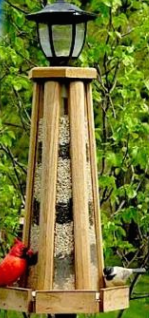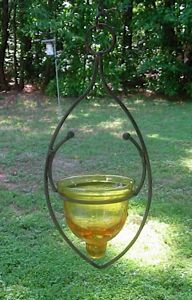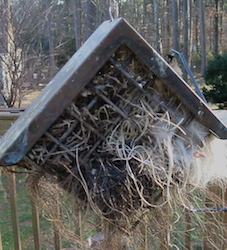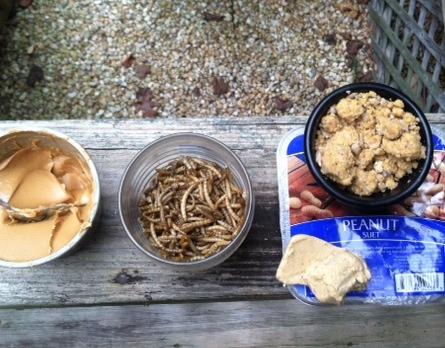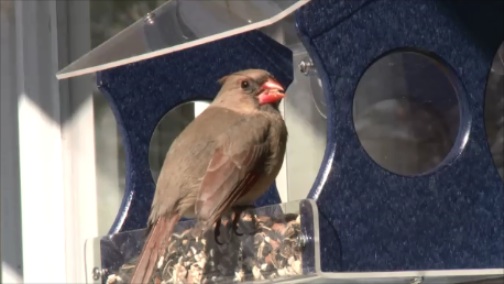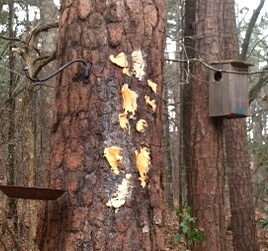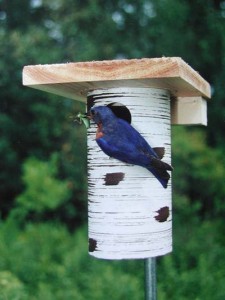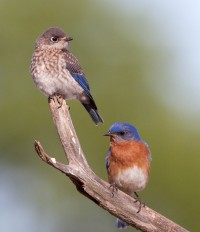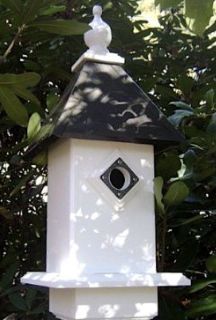-
Use a Sunflower Mix in Finch Feeders
Back oil sunflower seed is likely the most versatile of all birdseed. We prefer using the meats or hearts as they leave less ground waste and more species are apt to chow down! Even in finch feeders, using a mix that contains sunflower hearts will bring more color and more birds to the feeder.
During cold weather, a wide variety of feathered friends will absolutely find chopped sunflower a tasty treat! Cardinals, who’d rather not perch on narrow trays, chickadees, warblers, bluebirds, Carolina wrens and the other usual suspects will go for the high fat, high protein seed.
When chopped and mixed with thistle (a popular store-bought mix) it provides a hearty meal for many! Finch feeders with trays accommodate more birds than those with perches alone too. Because thistle won’t germinate and the sunflower is void of shells… it’s a really clean seed mix with almost zero waste. Sure, thistle hulls will accumulate, but no weeds will sprout! Just scoop it up with a small garden shovel every few weeks.
We promise, just because a feeder is called by a certain name or kind- doesn’t mean that’s all it does. Finch feeders need not only offer thistle for finches! And by the way, you can fashion a great jelly feeder for orioles using a small hanging candle holder, suet feeders rock for offering nesting materials… get the picture?
-
Best Cold Weather Offerings at Window Bird Feeders
Recently the question was posed by a customer on our Facebook page: “Any advice for keeping birds fat & happy through the coming cold snap?” Absolutely!
Basically, birds need higher fat and carbohydrate type foods that are easier and/or faster to digest during frigid weather.
Aside from topping off basic seed feeders, you can utilize window bird feeders and other platforms for these kinds of treats. Suet cakes broken into chunks, any kind of nuggets or crumbles, even home-made suet mixes and bluebird delight (recipes on our website) are ideal for open style window feeders.
Water… don’t forget that fresh water’s extremely important when all natural sources have frozen. Birds will flock to a heated bath throughout the entire winter season!
Since freezing weather always brings more birds around to feeders, you can easily set up a new feeding space or two without additional feeders per se. Offer more of those high fat, high carb
foods using suet or peanut butter smeared right on a tree trunk! Nuthatches, warblers, chickadees and every species of woodpecker will go for it in a snap. The extra calories serve them well helping to maintain body temperature and warmth overnight.
While you’re toasty warm inside, please remember feathered friend’s survival tactics and help them out during frigid weather!
-
They’ll Be Scouting Bluebird Houses Soon!
“Yesterday was very bright sun, but still cool with a heavy frost this morning. By late evening there were bluebird families sitting on high line wires & fence lines and males were singing from tree tops all along the roads where I have up bluebird houses. You see families of bluebirds right now at every people house that has up nesting boxes in their yards!”
See? That’s from a bluebird expert… the scouts will be out and about very soon, busy claiming their territory and the best spring digs in hopes of attracting a mate for the cycle of life that is nesting season! It’s a great time of year for all those “people houses” who host feathered friends too.
If you’ve never experienced a family of blues in your yard… this is the year you must try! For those who’ve hosted, and even monitor
ed nests, the rewards need not be explained. Mom & Dad raise nestlings with some pretty amazing teamwork and TLC. Should bluebirds stick around for a second clutch (very common if the first fledges are successful) you’ll see those juveniles help parents raise the new babies. Totally cool indeed!
Bluebird houses are best placed in an open area, mounted at about 5 feet high. The houses can be higher, but will prove difficult to monitor-which is a bummer. Folks actually help bluebirds thrive by looking out for them and monitoring their houses.
Everyone starts somewhere, so an absolute knowledge of the bird isn’t required – but some basic know-how and what to watch for are best for the birds. The North American Bluebird Society (NABS) actually rates and approves birdhouses suited for blues. Should you plan to monitor this year, look for a NABS Approved Bluebird House.
The website Sialis.org has a wealth of information in an easy to navigate format. Not just for bluebirds, but info about most North American cavity nesters. Your state may even have a bluebird society or association who’d be thrilled to help get you started with hosting bluebirds!

